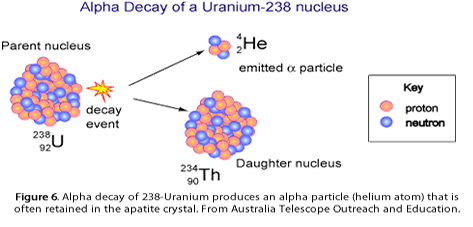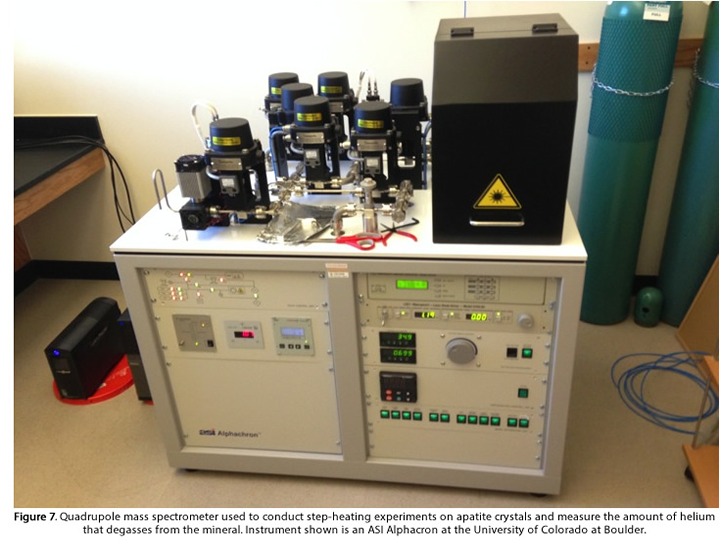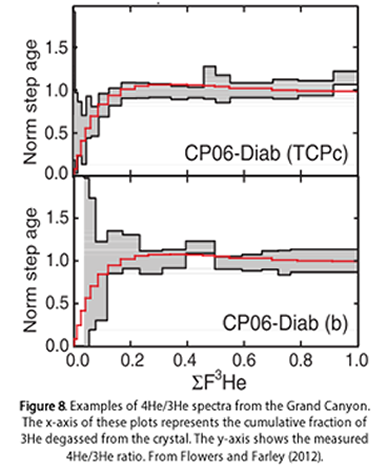4He/3He THERMOCHRONOMETRY
A wide variety of methods have been employed to study the incision of the Grand Canyon and the uplift of the Colorado Plateau including detailed geologic mapping, apatite fission track and U-Th/He thermochronometry, U-Pb speleothem dating, and an array geophysical techniques. Most recently, apatite 4He/3He thermochronometry has been utilized to better constrain the low-temperature (~90-30 °C) history of the canyon, specifically to address the unresolved timing of canyon incision (Flowers and Farley, 2012).
 Helium isotopes are extensively used as geologic chronometers, most frequently in the mineral apatite, which is a common accessory phase in many igneous and metamorphic rocks and a detrital grain in sedimentary rocks. 3He is the stable isotope of helium while 4He is a decay product of U and Th series nuclides, and to a lesser extent, 147Sm (Fig. 6). The 4He/3He method in particular utilizes the spatial distribution of radiogenic 4He in an apatite crystal to constrain thermal histories of rocks down to ~30 °C (Shuster and Farley, 2004). The spatial distribution of a radiogenic noble gas like helium in an apatite crystal reflects that sample’s thermal history, and accordingly can be used to provide direct constraints on the thermal history if the parent nuclide distribution and diffusive properties are known (Shuster and Farley, 2004). Because 4He/3He is the lowest temperature thermochronometer currently available to geologists, it theoretically provides the greatest sensitivity to canyon incision (i.e. when rocks reach near-surface temperatures, and by extension, near-surface positions in the crust).
Helium isotopes are extensively used as geologic chronometers, most frequently in the mineral apatite, which is a common accessory phase in many igneous and metamorphic rocks and a detrital grain in sedimentary rocks. 3He is the stable isotope of helium while 4He is a decay product of U and Th series nuclides, and to a lesser extent, 147Sm (Fig. 6). The 4He/3He method in particular utilizes the spatial distribution of radiogenic 4He in an apatite crystal to constrain thermal histories of rocks down to ~30 °C (Shuster and Farley, 2004). The spatial distribution of a radiogenic noble gas like helium in an apatite crystal reflects that sample’s thermal history, and accordingly can be used to provide direct constraints on the thermal history if the parent nuclide distribution and diffusive properties are known (Shuster and Farley, 2004). Because 4He/3He is the lowest temperature thermochronometer currently available to geologists, it theoretically provides the greatest sensitivity to canyon incision (i.e. when rocks reach near-surface temperatures, and by extension, near-surface positions in the crust).
The quality of data obtained using the 4He/3He method is dependent on the quality of the individual apatite crystals that are dated. First, all of the apatite within the sample is isolated using typical mineral separation procedures involving heavy liquids and magnetic separation. Individual crystals are then selected on the basis of large size and euhedral morphology; large, ‘beautiful’ grains are ideal in order to minimize α-ejection corrections (where the radiogenic helium is ejected from the crystal near the edges) and the effects of U or Th-rich inclusions within the grain. The apatite crystals are irradiated with protons to produce a known, uniform distribution of spallogenic 3He, which serves as a baseline for determining 4He concentrations (Shuster et al., 2004). Each selected grain is then measured to calculate the corresponding α-ejection correction, loaded into a small platinum tube, and placed in a copper foil sheath mounted atop a thermocouple in a projector lamp diffusion cell. Over a period of several hours and temperatures between 200 and 500 °C, helium is degassed from the crystal, purified, and measured on a mass spectrometer (Fig. 7). 4He/3He spectra are computed from these measurements, bulk normalized to the total 3He and 4He in the sample, and then normalized further by applying the grain size dependent α-ejection corrections.

 The resultant 4He/3He spectra from an analyzed sample provide a rigorous constraint on that sample’s thermal history. The proper time-temperature path for the sample should provide a best fit for the 4He/3He spectra since the latter will have a limited number of t-T paths that are consistent with its shape (Fig. 8; Shuster and Farley, 2004; Farley et al., 2010). This constraint is especially powerful in conjunction with apatite U-Th/He (AHe) ages from the same sample. In their recent study of the Grand Canyon, Flowers and Farley (2012) performed both inverse modeling on both 4He/3He spectra and AHe ages from the same samples with the requirement that potential thermal histories (i.e. t-T paths) must fit both sets of data (Fig. 8). In these inverse models, the mean effective uranium concentration (eU) in the apatite crystal was defined and a eU zonation profile was assumed to account for the effects of both radiation damage and parent nuclide zonation. Forward models were then run to predict 4He/3He profiles for the best-fit thermal history and assess the influence of eU zonation and other potentially complicating effects. Accordingly, successful interpretation of any 4He/3He data requires a thorough understanding of He behavior in apatite (Flowers and Farley, 2012).
The resultant 4He/3He spectra from an analyzed sample provide a rigorous constraint on that sample’s thermal history. The proper time-temperature path for the sample should provide a best fit for the 4He/3He spectra since the latter will have a limited number of t-T paths that are consistent with its shape (Fig. 8; Shuster and Farley, 2004; Farley et al., 2010). This constraint is especially powerful in conjunction with apatite U-Th/He (AHe) ages from the same sample. In their recent study of the Grand Canyon, Flowers and Farley (2012) performed both inverse modeling on both 4He/3He spectra and AHe ages from the same samples with the requirement that potential thermal histories (i.e. t-T paths) must fit both sets of data (Fig. 8). In these inverse models, the mean effective uranium concentration (eU) in the apatite crystal was defined and a eU zonation profile was assumed to account for the effects of both radiation damage and parent nuclide zonation. Forward models were then run to predict 4He/3He profiles for the best-fit thermal history and assess the influence of eU zonation and other potentially complicating effects. Accordingly, successful interpretation of any 4He/3He data requires a thorough understanding of He behavior in apatite (Flowers and Farley, 2012).
The discussion on the next page focuses on the results of this recent 4He/3He work in the Grand Canyon, its agreement with existing data and models, and implications for the tectonic history of the western U.S.